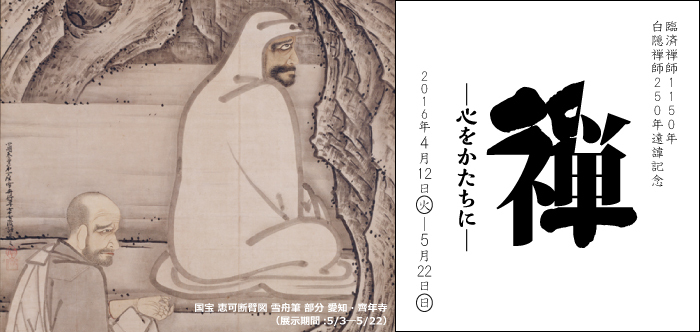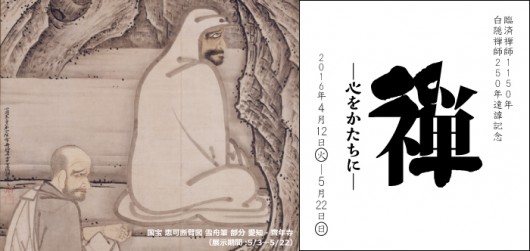Event
The Art of ZEN From Mind to Form
Apr 12, 2016 (tue) – May 22, 2016 (sun)
Hours: 9:30 ~ 18:00/Tuesday ~ Thursday and Weekend
9:30 ~ 20:00/Friday(entry up to 30 minutes before closing.)
Closed: Monday(Tuesday if the Monday is a national holiday)
Admission:
Adult \1,500 (\1,300)
Univ. Student \1,200 (\1,000)
High School Student \900 (\700)
Admission is free under middle school students.
*(Fees in parentheses for groups of twenty or more)
http://www.kyohaku.go.jp/eng/special/index.html
Venue
Kyoto National Museum
http://www.kyohaku.go.jp/eng/index_top.html
Access: 527 Chaya-cho, Higashiyama-ku, Kyoto, 605-0931, Japan
Tel: 075-541-1151
Hours: 9:30 ~ 18:00/Tuesday ~ Thursday and Weekend
9:30 ~ 20:00/Friday(entry up to 30 minutes before closing.)
Closed: Monday(Tuesday if the Monday is a national holiday)
Description
Zen is one of the words most commonly associated with Japan, but in reality it is a tradition that originated in India with the First Zen Patriarch Bodhidharma, thought to have lived in the late 400s and early 500s. From there Zen was transmitted to China, where it was called Chan, later arriving in Japan during the Kamakura period (1185–1333). Originally Zen priests in Japan were patronized by members of the elite, including feudal lords and warriors, the aristocracy, and even the imperial family. Eventually this type of Buddhism spread to all levels of society. Throughout this time, it wielded considerable influence over Japanese culture. Since the twentieth century, the popularity of Zen has spread to North America, Europe, and beyond.
Two branches of Zen in Japan, Rinzai and Ōbaku, trace their lineages back to the Chinese Chan priest Linji Yixuan (J: Rinzai Gigen, died 866). The year 2016 marks the 1150th anniversary of Linji’s death; it is also a year of grand rituals honoring the 250th memorial of the death of Hakuin Ekaku (1685–1769), the Japanese Rinzai Zen priest who revived the sect in the mid-Edo period. This exhibition The Art of Zen: From Mind to Form, commemorates these two milestones.
Zen places special emphasis on the transmission of Buddhist wisdom through experience and intuition, on understanding gained outside of words and text—transmission from heart to heart, teacher to disciple. One of the most cogent lines in the fundamental Buddhist scripture the Heart Sutra is the phrase “form is nothing but emptiness, emptiness is nothing but form.” What kind of artistic forms could possibly express the emptiness grasped by an enlightened mind? This exhibition examines the profound meanings of artworks produced in association with this sect over the centuries. It touches upon Chan’s rise in China, investigates how it was transmitted to Japan, and attempts to give a comprehensive understanding of Zen’s development and influence within this country.
There are fifteen major Rinzai and Ōbaku Zen temples in Japan today, all of whom have thrown their full support behind this project. For this reason, the exhibition will feature a selection unprecedented in quantity and quality of portraits, calligraphy, sculpture, paintings, and decorative or ritual objects, including many of the greatest masterpieces associated with Zen. There will be several rotations of the galleries in order to show a total of nearly 220 works over the course of the exhibition. Over half of these are registered National Treasures or Important Cultural Properties—a never before assemblage of Japan’s rarest and most significant Zen-related artworks.
The exhibition is divided into five sections, “The Establishment of Chan Buddhism,” “The Development of Rinzai Zen,” “Sengoku Warlords and Early Modern Zen Priests,” “Zen and Buddhist Deities,” and “The Spread of Zen Culture.” Together, they provide an extraordinary opportunity to experience in person the visual forms representing the spirit of Zen.






